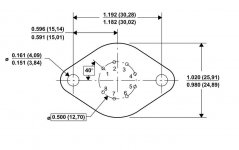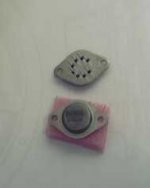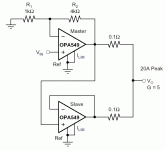I don´t know. If i would, i would´nt ask. It´s more because TI uses OPA548 in the audio amplifier aplication note.
protos said:I am finishing an OPA549 based power amp.Will report soon.
Protos,
I made a unity gain amp with OPA549, and the thing is.... there's nothing at the output. Do I need to apply some voltage to the "enable" pin? According to the datasheet, the enable pin can be left open for normal use. So, I just left it open. Hmmm.... I must be doing something wrong. BTW, I put 4.7k resistor for the current limit.
PCB's for active crossover
Marchand has both a PCB for $10 and a complete kit.
http://www.marchandelec.com/xm1.htm
Elliot Sound Products has a PCB that can be built as a 2 way linkwitz riley 4th order xover, or a three way version.
http://www.sound.westhost.com/project09.htm
Marchand has both a PCB for $10 and a complete kit.
http://www.marchandelec.com/xm1.htm
Elliot Sound Products has a PCB that can be built as a 2 way linkwitz riley 4th order xover, or a three way version.
http://www.sound.westhost.com/project09.htm
Re: PCB's for active crossover
active crossover with an opa549??
why do you want an active crossover capable of 10 amps?
are you planning to use only one amp, and multiple high power active XOs?
would be interessting to try, I never heard about this concept
David B said:Marchand has both a PCB for $10 and a complete kit.
http://www.marchandelec.com/xm1.htm
Elliot Sound Products has a PCB that can be built as a 2 way linkwitz riley 4th order xover, or a three way version.
http://www.sound.westhost.com/project09.htm
active crossover with an opa549??
why do you want an active crossover capable of 10 amps?
are you planning to use only one amp, and multiple high power active XOs?
would be interessting to try, I never heard about this concept
Re: PCB for active crossover
What's the Taiwanese you want to translate?
Coffin from TWN



Jarno said:C29, C30 ¡õ whish O 0.1uf ¡õq¡õe, ¡õA¡§ blind WOS-CON 47uf ¡õ the perspiration q stalk ¡õq¡õe¡õA¡õ ì® dodges Ù¾ ᤠ¡õReset does obeisance ¡õD ¤£ ¡õO¨º or ¡õe¡õ ö¸ the hole M¡õA¡õ¡õ¡õu¡õ twelfth branch u¡õn¡õ [ ¡èW¡è@ picks 100uF¡õq¡õe¡õN ¤£ ¥Î ¡§C Omega ¡õ } the knack often ¡õnReset¡õ shouts loses @¡èF¡õC
(ok, so translating taiwanese with a chinese dictionary doesn't work) [/B]
What's the Taiwanese you want to translate?
Coffin from TWN



till said:yeah, and whats very cool is, for germany they need only one or two days also!
Go with it for the subwoofer, will be ok.
I will try out OPA544 next. I don´t really need the power. Very cool are those high voltage high current OP amps in TO3 with 8 pins - only i don´t know how to mount them on a heatsink - if i drill than many holes there is not much heatsink left for thermal contact.
Yes
Where can I find this Heatsink type ?😕
I got a OP501AM on hand....
Coffin

Attachments
till said:have to drill a lot of holes?
This is one way...

I know some way out there is a TO-3 8 pin IC socket! With heatsink! 😱
Where can I find it?

Coffin



Re: Re: PCB's for active crossover
Who on earth would make an active crossover capable of 10 amps? 🙂 🙂 🙂 OPA549 is for a subwoofer amp not for an active crossover. I was curious what protos' project was about.
Bricolo said:
active crossover with an opa549??
why do you want an active crossover capable of 10 amps?
are you planning to use only one amp, and multiple high power active XOs?
would be interessting to try, I never heard about this concept
Who on earth would make an active crossover capable of 10 amps? 🙂 🙂 🙂 OPA549 is for a subwoofer amp not for an active crossover. I was curious what protos' project was about.
Hi Jazz,
I got one channel working perfectly.I originally had the same problem till I realized that I hadn't connected the Ref pin to ground(I used no current limit).So Ilim pin is connected directly to Ref and they are connected to Ground.Enable pin is open.I had problems though with the other channel because it was giving me about 4-5V of offset and I didn't manage to get it right.I have ordered some more samples in case I managed to damage that one although I don't see how with all those safety features they have they should be practically indestructible.However this gave me the chance to substitute a LM3875 on hand and make some interesting A/B comparisons.
Overall I would say my preference went to the 549.More neutral,less peaky in the upper mids and more power and control.
More testing is in order since they haven't broken in completely yet.
I got one channel working perfectly.I originally had the same problem till I realized that I hadn't connected the Ref pin to ground(I used no current limit).So Ilim pin is connected directly to Ref and they are connected to Ground.Enable pin is open.I had problems though with the other channel because it was giving me about 4-5V of offset and I didn't manage to get it right.I have ordered some more samples in case I managed to damage that one although I don't see how with all those safety features they have they should be practically indestructible.However this gave me the chance to substitute a LM3875 on hand and make some interesting A/B comparisons.
Overall I would say my preference went to the 549.More neutral,less peaky in the upper mids and more power and control.
More testing is in order since they haven't broken in completely yet.
protos said:I originally had the same problem till I realized that I hadn't connected the Ref pin to ground(I used no current limit).
Indeed, I didn't connect the Ref pin to ground. 😉 Now, OPA549 with unity gain works. Next, I'm gonna give some gain to it. Thanks, protos.
parralel/bride of opa549
http://focus.ti.com/download/trng/docs/seminar/sigcond_5.pdf
page 20 the super power amp.
Have any body build this circuit used for audio.
does the resistors have to mached ?
It look very simple I wonder if the parralel side will "fight" and get very hot.
jc dk.
http://focus.ti.com/download/trng/docs/seminar/sigcond_5.pdf
page 20 the super power amp.
Have any body build this circuit used for audio.
does the resistors have to mached ?
It look very simple I wonder if the parralel side will "fight" and get very hot.
jc dk.
TI parallel circuit
The reason I was asking for comments over that OP549 parallel arrangement, is because they do not a very good thing, as pointed up to me by Kuei Yang Wang over a bridging circuit I had seen.
The output of amp A1 feeds the input of amp A2, which means it's feeding distortion and all that.
Once again, it was no suggested specifically for audio. So I wonder.
Carlos
The reason I was asking for comments over that OP549 parallel arrangement, is because they do not a very good thing, as pointed up to me by Kuei Yang Wang over a bridging circuit I had seen.
The output of amp A1 feeds the input of amp A2, which means it's feeding distortion and all that.
Once again, it was no suggested specifically for audio. So I wonder.
Carlos
why should one parallel them? isn´t 8 or 10 A enough? If you really need more, use some paralleld really big sourcefollowers behind them?
Parallel
No, I have nothing against paralleling amps. I even opened a specific thread on this Forum willing to discuss bridging and paralleling gainclones.
What I don't know is if this way suggested by TI, different from the one I knew and also suggested by National, was a valid one audio wise.
Carlos
till said:why should one parallel them? isn´t 8 or 10 A enough? If you really need more, use some paralleld really big sourcefollowers behind them?
No, I have nothing against paralleling amps. I even opened a specific thread on this Forum willing to discuss bridging and paralleling gainclones.
What I don't know is if this way suggested by TI, different from the one I knew and also suggested by National, was a valid one audio wise.
Carlos
Protos,
How much is the capacitance in the power supply you used? I know that OPA549 has less PSRR than LM3875.
How much is the capacitance in the power supply you used? I know that OPA549 has less PSRR than LM3875.
Heatsink
10 holes per OPA549...
I tried making a prototype heatsink with an aluminum plate measuring 9x4x0.25". I copied the mechanical drawing to PPT and adjusted its size to exactly the same as shown in the drawing. Then I printed it out on a paper, cut it, pasted it on the aluminum plate, punched, then drilled 10 holes using drill press. The whole process could be done in 10 to 15 minutes except for the making taps for mounting the amp. Before installing the amp to the aluminum plate, all the pins were masked (insulated) with heat-shrinkage cable cut to the 2/3 of the length of the pin.
In short, drilling holes is not so much time-consuming and you have enough area, which will contact the amp, for heat transfer. If you can find a heatsink for TO3 devices without any pre-drilled holes, you have no problem.
I'll post some photos if you're interested. 🙂
till said:have to drill a lot of holes?
10 holes per OPA549...
I tried making a prototype heatsink with an aluminum plate measuring 9x4x0.25". I copied the mechanical drawing to PPT and adjusted its size to exactly the same as shown in the drawing. Then I printed it out on a paper, cut it, pasted it on the aluminum plate, punched, then drilled 10 holes using drill press. The whole process could be done in 10 to 15 minutes except for the making taps for mounting the amp. Before installing the amp to the aluminum plate, all the pins were masked (insulated) with heat-shrinkage cable cut to the 2/3 of the length of the pin.
In short, drilling holes is not so much time-consuming and you have enough area, which will contact the amp, for heat transfer. If you can find a heatsink for TO3 devices without any pre-drilled holes, you have no problem.
I'll post some photos if you're interested. 🙂
The reason for paralleling them is not so much for current, but for power dissipation reasons. If you run those opamps with 8A with their maximum supply voltage for any length of time with any voltage across them (like in a linear amp), they will go into thermal shutdown and not work well. Paralleling them makes the effective allowable power dissipation be equal to the sum of the power dissipation ratings of the opamps, and will allow for greater output power.
- Status
- Not open for further replies.
- Home
- Amplifiers
- Chip Amps
- Opa549



